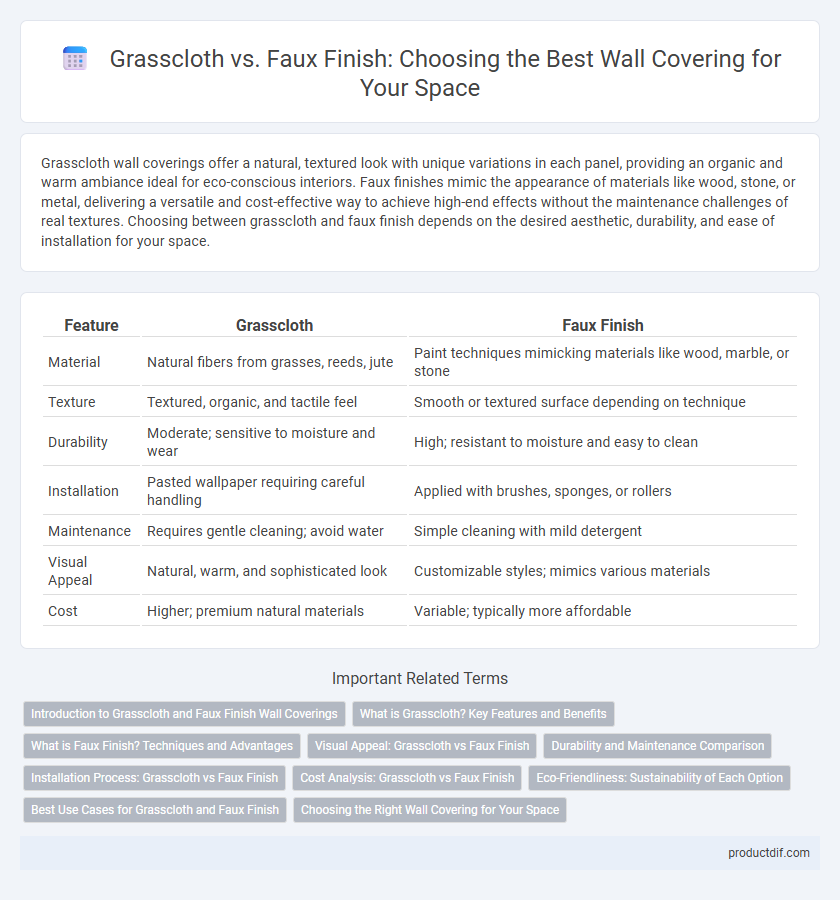Grasscloth wall coverings offer a natural, textured look with unique variations in each panel, providing an organic and warm ambiance ideal for eco-conscious interiors. Faux finishes mimic the appearance of materials like wood, stone, or metal, delivering a versatile and cost-effective way to achieve high-end effects without the maintenance challenges of real textures. Choosing between grasscloth and faux finish depends on the desired aesthetic, durability, and ease of installation for your space.
Table of Comparison
| Feature | Grasscloth | Faux Finish |
|---|---|---|
| Material | Natural fibers from grasses, reeds, jute | Paint techniques mimicking materials like wood, marble, or stone |
| Texture | Textured, organic, and tactile feel | Smooth or textured surface depending on technique |
| Durability | Moderate; sensitive to moisture and wear | High; resistant to moisture and easy to clean |
| Installation | Pasted wallpaper requiring careful handling | Applied with brushes, sponges, or rollers |
| Maintenance | Requires gentle cleaning; avoid water | Simple cleaning with mild detergent |
| Visual Appeal | Natural, warm, and sophisticated look | Customizable styles; mimics various materials |
| Cost | Higher; premium natural materials | Variable; typically more affordable |
Introduction to Grasscloth and Faux Finish Wall Coverings
Grasscloth wall coverings are crafted from natural fibers like jute, hemp, or arrowroot, offering a textured, organic aesthetic that enhances interior spaces with warmth and depth. Faux finish wall coverings mimic the appearance of materials such as wood, stone, or plaster, providing versatile and cost-effective options to achieve sophisticated design effects. Both options serve distinct decorative purposes, with grasscloth emphasizing natural texture and faux finishes delivering customizable visual styles.
What is Grasscloth? Key Features and Benefits
Grasscloth is a natural wall covering made from woven fibers of plants like jute, hemp, or arrowroot, known for its unique texture and organic aesthetic. Key features include its eco-friendliness, durability, and ability to add warmth and depth to interiors through natural variations in color and pattern. Benefits of grasscloth encompass enhancing room acoustics, being highly breathable, and offering a sophisticated, timeless look that complements various design styles.
What is Faux Finish? Techniques and Advantages
Faux finish is a decorative painting technique that mimics the appearance of materials like wood, marble, or plaster, often used as an alternative to traditional wall coverings like grasscloth. Techniques include sponging, rag rolling, and color washing to create textures and depth, offering a customizable and cost-effective solution for wall decoration. Advantages of faux finishes include durability, ease of maintenance, and the ability to achieve unique, artistic effects that can be tailored to various interior design styles.
Visual Appeal: Grasscloth vs Faux Finish
Grasscloth wall coverings offer a natural, textured aesthetic with subtle variations in color and pattern, creating a warm, organic ambiance ideal for sophisticated interiors. Faux finishes mimic materials such as marble, wood, or plaster, delivering dramatic visual effects and customizable patterns that enhance depth and character in a space. The choice between grasscloth and faux finish depends on the desired visual impact, with grasscloth emphasizing natural texture and faux finish providing versatile artistic expression.
Durability and Maintenance Comparison
Grasscloth wall coverings offer natural texture and eco-friendly appeal but are less durable, prone to tearing and staining, requiring gentle cleaning and avoiding moisture. Faux finish wall coverings mimic expensive materials with enhanced durability, resist scratches and stains, and allow easy maintenance through simple wiping or occasional repainting. Choosing between grasscloth and faux finish depends on balancing the desire for natural aesthetics with practical considerations of longevity and upkeep.
Installation Process: Grasscloth vs Faux Finish
Grasscloth wall covering requires careful installation due to its delicate natural fibers, necessitating a skilled hand to align seams precisely and avoid damage from moisture or adhesives. Faux finish, typically applied with paint or plaster techniques, allows for more flexibility and quicker application on various surfaces without special preparation. The installation of faux finishes generally demands less expertise and cleanup, making it a more convenient option for DIY enthusiasts compared to the intricate, labor-intensive process of grasscloth installation.
Cost Analysis: Grasscloth vs Faux Finish
Grasscloth wall coverings typically cost between $15 and $30 per roll, reflecting their natural fibers and artisanal production, while faux finishes often range from $10 to $20 per gallon, making them a more budget-friendly option for covering large areas. Installation expenses for grasscloth are higher due to the delicate nature of the material requiring skilled labor, whereas faux finishes can be applied by professionals or DIY enthusiasts, reducing overall costs. Long-term maintenance and durability also impact total cost considerations, with grasscloth demanding careful upkeep and faux finishes offering easier cleaning and touch-up solutions.
Eco-Friendliness: Sustainability of Each Option
Grasscloth wall coverings, made from natural fibers like jute, hemp, and seagrass, offer superior eco-friendliness due to their biodegradability and renewable sourcing. Faux finishes, often created with synthetic materials and chemical-based paints, tend to have a higher environmental impact and limited recyclability. Choosing grasscloth supports sustainable interior design by reducing synthetic waste and promoting natural resource conservation.
Best Use Cases for Grasscloth and Faux Finish
Grasscloth wall coverings excel in creating natural, textured surfaces ideal for living rooms, bedrooms, and dining areas where warmth and organic aesthetics are desired. Faux finishes provide versatile, cost-effective solutions that mimic wood, marble, or plaster, making them suitable for high-traffic zones like kitchens, bathrooms, and commercial spaces. Both options enhance interior design, with grasscloth favored for its eco-friendly appeal and faux finishes chosen for durability and easy maintenance.
Choosing the Right Wall Covering for Your Space
Grasscloth offers a natural, textured aesthetic made from woven plant fibers, ideal for adding warmth and organic appeal to living rooms or bedrooms. Faux finishes replicate materials like wood, marble, or plaster, providing cost-effective versatility and a unique artistic statement suitable for accent walls or commercial spaces. Selecting between grasscloth and faux finishes depends on desired texture, maintenance levels, and the room's lighting conditions to achieve a harmonious and durable wall covering solution.
Grasscloth vs Faux finish Infographic

 productdif.com
productdif.com